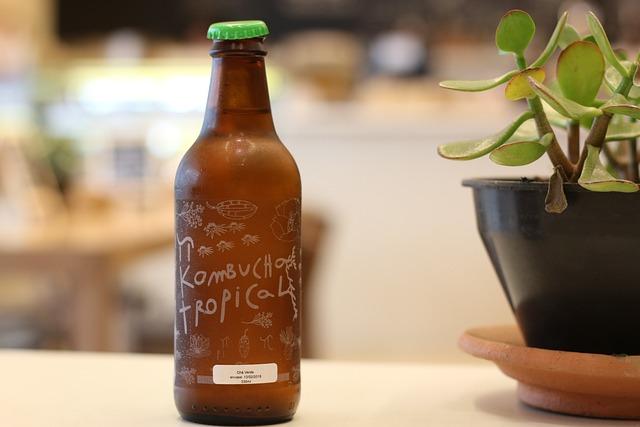Delve into the intriguing world of kombucha, where a symbiotic colony of bacteria and yeast, known as the “kombucha organism,” works its magic to transform humble tea into a tangy and probiotic-rich elixir. Join us on a journey to uncover the secrets behind this living culture, renowned for its health benefits and unique fermentation process. Embark on a deeper exploration of the kombucha organism and unlock the mysteries of this ancient tradition with a modern twist.
Table of Contents
- Exploring the Fascinating World of Kombucha Organisms
- Unveiling the Mysteries of Kombucha SCOBY: Growth, Care, and Maintenance
- Fermented Bliss: Harnessing the Power of Kombucha Organisms
- Top Tips for Brewing Delicious and Healthy Kombucha at Home
- Q&A
- In Conclusion
Exploring the Fascinating World of Kombucha Organisms
Kombucha organisms are like tiny wizards brewing magic in a jar. These microbial communities consist of various bacteria and yeast strains working together in harmony to transform tea and sugar into a tangy, fizzy elixir. Each sip of kombucha is a testament to the intricate dance of these living organisms.
From Acetobacter to Saccharomyces, kombucha cultures are a diverse ecosystem with unique roles. While some bacteria create acetic acid, giving kombucha its signature tartness, yeast species produce ethanol and carbon dioxide, resulting in its effervescence. Together, they create a symphony of flavors and textures that make kombucha a delightful beverage enjoyed by many around the world.


Unveiling the Mysteries of Kombucha SCOBY: Growth, Care, and Maintenance
The symbiotic culture of bacteria and yeast, known as SCOBY, plays a vital role in the art of brewing kombucha. To nurture this living organism effectively, mastering the ins and outs of its growth, care, and maintenance is crucial. SCOBY, often referred to as the “mother” in the world of kombucha, is responsible for fermenting the sweet tea mixture into the tangy, probiotic-rich beverage loved by many.Proper care for your SCOBY involves creating an optimal environment for its growth. This includes keeping it in a glass container away from direct sunlight, maintaining a suitable temperature range for fermentation, and feeding it with a blend of tea and sugar regularly. Additionally, ensuring cleanliness during handling and transferring of the culture is essential to prevent contamination. By following these simple yet essential steps, you can harness the full potential of your kombucha SCOBY and enjoy the delicious results it yields.

Fermented Bliss: Harnessing the Power of Kombucha Organisms
In the world of fermenting wonders, kombucha organisms stand out as tiny powerhouses of health benefits and flavor. These living cultures, also known as SCOBY (Symbiotic Culture Of Bacteria and Yeast), create the magic behind the tangy, effervescent elixir that is kombucha. Harnessing the collective might of these probiotic warriors can lead to a symphony of taste and wellness in every sip.Why Kombucha Organisms Are Superstars:
- SCOBY transforms sweet tea into a fizzy, flavorful beverage packed with probiotics.
- The fermentation process by these organisms produces organic acids, enzymes, and vitamins beneficial for gut health.
- Kombucha organisms can adapt to various tea blends, resulting in a diverse range of flavors and profiles.
Exploring the SCOBY Universe:
- SCOBY’s appearance might be strange, but its ability to ferment tea into a refreshing drink is truly remarkable.
- These organisms require a controlled environment with the right balance of temperature, pH levels, and nutrition to thrive.
- When handled with care and precision, kombucha cultures can continuously reproduce, offering a sustainable source of homemade goodness.


Top Tips for Brewing Delicious and Healthy Kombucha at Home
To ensure your homemade kombucha turns out both delicious and packed with health benefits, here are some expert tips to guide you on your brewing journey:
**Ingredients Matter:**
Start with high-quality ingredients to set the foundation for a tasty brew. Opt for organic tea to avoid pesticides and ensure the best flavor. Use organic cane sugar as the primary food source for the kombucha culture, ensuring a healthy fermentation process.
**Maintain Cleanliness:**
Keep your brewing equipment squeaky clean to prevent unwanted bacteria from interfering with the kombucha fermentation. Use hot water and mild soap for regular cleaning and sanitize with white vinegar. Ensure a sterile environment to cultivate a thriving and safe kombucha culture.
Q&A
Q: What exactly is a “kombucha organism”?A: The term “kombucha organism” refers to the symbiotic culture of bacteria and yeast (SCOBY) that is used to ferment sweetened tea and create kombucha.
Q: How does the kombucha organism work its magic?
A: The SCOBY metabolizes the sugar in the tea, producing beneficial acids, enzymes, and probiotics that give kombucha its unique taste and potential health benefits.
Q: Is the kombucha organism safe to consume?
A: When brewed properly, kombucha is generally safe to drink. However, it’s essential to follow proper brewing techniques to prevent contamination and ensure a healthy brew.
Q: What are the potential health benefits of consuming kombucha?
A: Kombucha is believed to have probiotic properties that may support gut health, improve digestion, and boost the immune system. It’s also rich in antioxidants, which can help fight inflammation and oxidative stress.
Q: Can anyone brew kombucha at home using the kombucha organism?
A: Yes, brewing kombucha at home is quite popular. With the right ingredients, equipment, and guidance, anyone can try their hand at brewing this fizzy, tangy probiotic beverage.
Q: Are there any risks associated with consuming kombucha?
A: While kombucha is generally safe for most people, individuals with compromised immune systems, pregnant women, and those with certain health conditions should consult their healthcare provider before consuming it.
Q: How can one ensure the quality and safety of homemade kombucha?
A: To ensure the quality and safety of homemade kombucha, it’s crucial to maintain proper hygiene during the brewing process, monitor fermentation closely, and store the finished product correctly to prevent contamination.
